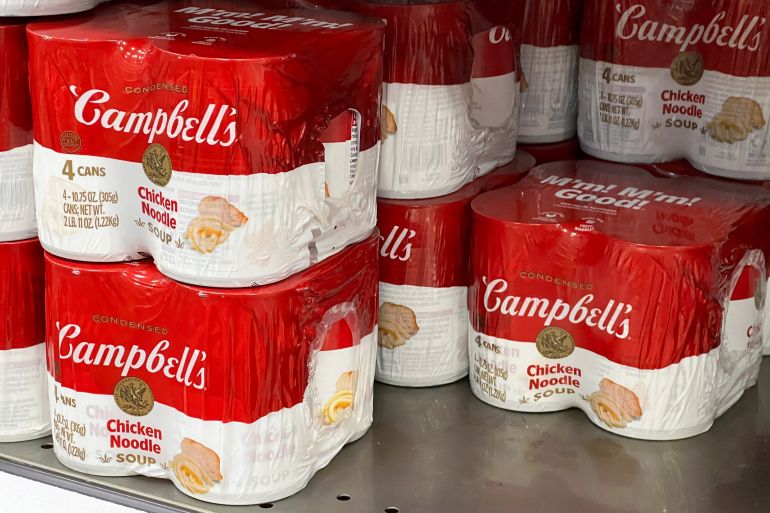Campbell’s sees tariff hit in year ahead as economic uncertainty looms
The maker of the Goldfish snack also plans to stop using artificial dyes by the second half of its 2026 fiscal year.

Published On 3 Sep 20253 Sep 2025
Campbell’s Co expects sales to fall in the coming year as tariff-driven economic uncertainty weighs on the food maker.
In its fourth quarter earnings report released Wednesday, the New Jersey-based company said its sales will likely remain flat or decline by as much as 2 percent in the coming year.
Recommended Stories
list of 4 itemsend of list
Campbell’s, which is best known for its canned soup products, said that it expects that tariffs will account for about 4 percent of the cost of goods for the 2026 fiscal year which started August 4.
The company says it plans to mitigate the cost with some price increases and other cost-saving measures as inflation weighs on how much consumers spend.
“Consumers continue to be increasingly deliberate in their food choices,“ CEO Mick Beekhuizen said.
The latest consumer price index report reflecting the month of July, and which came out in mid-August, showed that prices overall for food at home increased by 2.2 percent compared over the same period a year ago.
“The company faces a dynamic operating and regulatory environment resulting in substantial input cost pressures, primarily driven by tariffs, which, despite significant mitigation efforts, reduce its earnings outlook for the upcoming fiscal year,” Beekhuizen said.
Campbell expects annual adjusted profit per share to fall up to 18 percent to between $2.40 and $2.55, including tariffs, and below the estimates of $2.63, according to data compiled by LSEG.
Food brands like Campbells and its competitors use steel in their cans, which has been subject to steep tariffs. The Can Manufacturers Institute warned earlier this year that tariffs would put a strain on food producers, especially as domestic manufacturing of the steel used in cans has fallen by 75 percent over the last eight years.
“Domestic can makers and canned food producers now import nearly 80 percent of tin mill steel from trade allies,” Robert Budway, president of the Can Manufacturers Institute, said at the time.
Advertisement
Campbell’s Co reported net sales increased in the fourth quarter by 1 percent to $2.3bn. Prices also increased by 2 percent for the quarter, which offset a 4 percent decline in volume.
Food dye cuts
The maker of the Goldfish snack also plans to stop using synthetic food dyes in its products by the second half of the 2026 fiscal year. The company plans to replace them with more natural alternatives like annatto, an orange-red food condiment made from the seeds of the achiote tree, and purple carrot juice in Lance crackers and V8 Splash.
It joins industry peers, including PepsiCo, Kraft-Heinz and Nestle, in replacing synthetic food dyes with natural ones in response to Health Secretary Robert F Kennedy Jr’s “Make America Healthy Again” initiative and shifting consumer preferences.
On Wall Street, the company’s stock surged on the news, and as of 11:30am in New York (15:30 GMT), it was up by 4.6 percent.
